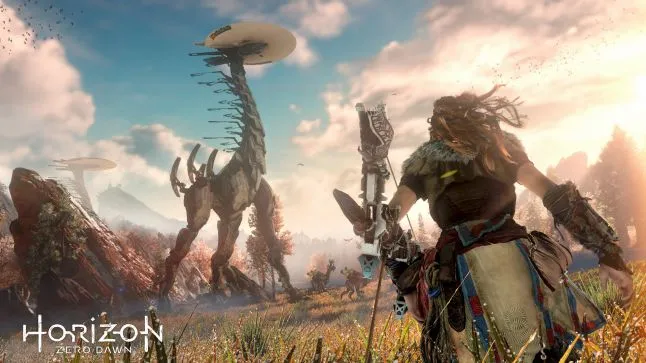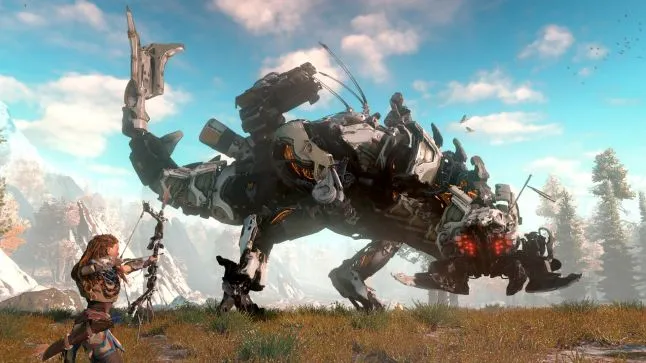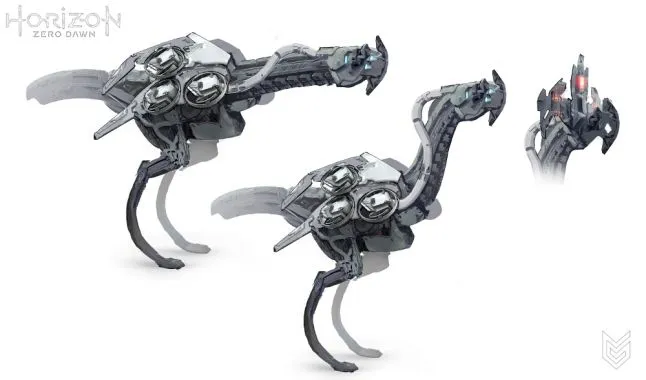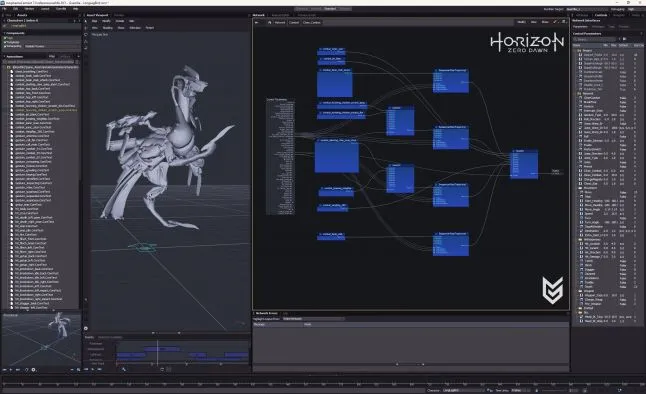Horizon Zero Dawn Fan Made Machines
One of the about memorable features of the recent PlayStation 4 title Horizon Naught Dawn are the sophisticated robots, known every bit Machines, that wander the game earth like a natural part of the landscape.
They are clearly automatons, with all their inner workings obviously visible. But they also exhibit unmistakable creature-similar behaviors and movements. These Machines are a key feature of the game's unique primordial futurist milieu.
How were these distinctive robot/creatures conceived of and designed? We talked with several devs from Guerrilla Games, the studio backside HZD, to see merely what went into the making of the Machines.
At the offset of the design process, the team queried local Holland universities, including the Delft University of Technology's robotics department, for assistance. (Among the insights gleaned -- far-robots would potentially be 3D printed.) Ane question the developers posed: Are at that place areas of nature that could exist improved upon?
"Skeletons, they told us," says January-Bart van Beek, studio art manager. "Skeletons are kind of shit, considering they're on the inside, surrounded past very soft tissue. And it's a single indicate of failure -- if your leg breaks, you're pretty much dead as an animal."

Tallneck
Instead, the profs suggested the possibility of something more like exoskeletons to the team--recollect lobsters, not humans, and y'all've got the right thought.
"If you look at some of our robot designs, yous can see the exterior has sort of a metal framework, and in that location is soft tissue on the insides, which also creates a user-friendly soft spot for arrows to be pumped into, " van Beek says.
"All these things came from the inspiration of the robotics engineer explaining to us how they would build a robotic T-Rex if they had to do that," he adds.

Thunderjaw
Originally, the machines weren't intended to have such beast-like movements. The squad initially made the machines behave in a way that was more, well, mechanical. "It felt besides much like a issues, like information technology wasn't moving the way information technology should be moving," says Richard Oud, lead creature animator.
To bring the designs into the game -- instead of waiting for a perfected model -- the team would take unpolished models directly from ZBrush, slap a skeleton in, and bring it right in. Even if information technology was running at a irksome FPS, it would give them some idea of the brute.
"Yous had to have big tough ones that were fast and deadly, and you as well wanted ones that were easier at the beginning of the game," says Blake Politeski, automobile designer.
"And at the same fourth dimension, nosotros needed to find means that these would fit in with the fiction of these sort of robots that are maintaining nature. They're part of nature, and so it had to fit with that narrative equally well."

Watchers
The modeling was in and of itself a colossal task. Information technology took "human being years" of work, and van Beek believes that information technology took five modelers around eight months for the T-King-similar Thunderjaw. And that was but on the modeling end: it was around xviii months from the initial sketch to get it working and enjoyable in-game.
Despite the work, the team had a "realization that if we would nail the Thunderjaw, we would sort of know how to make the game," van Beek says.
And to dial in how these robotic animals should move, the team even pulled in Dr. Stuart Sumida, who has done anatomical consulting on myriad projects including films The Panthera leo King, Dinosaur, Hercules, and Harry Potter, and Disney World's Countdown to Extinction and Expedition Everest rides. Oud likewise took a several calendar month long grade focused on brute and fauna animation, as well.

Stormbird
Blinking lights and heavy fights
Balancing the design of the animals with their in-game functions was some other challenge, especially in terms of the visual complication of the machines.
"In that location was ever a hazard peradventure that it would but overload everything, you'd end up with a Christmas tree problem, where you have all these kinds of blinking lights and dissimilar colors and you'd actually have no idea what'southward going on anymore," van Beek says.
Animation and design worked together on this outcome, and so that all of the diverse machines' gameplay elements were kept intact, while also keeping it clear to the players what they were there for.
Weight was as well a challenge. The bigger things are, the harder they fall, equally they say. Merely it also tends to hateful the slower they move. Dennis Zopfi, pb machine designer, mentioned this difficulty in the Behemoth in particular.
Behemoth
"From [an] AI and blitheness point, it was very difficult to get right ... you tin can't make the affair plow too fast, because then it loses its weight," Zopfi says.
"But if it cannot turn fast enough then, because the actor'southward very agile and athletic, so the players run past very fast and we had a lot of issues with making it look right only also making information technology responsive enough to deal with the player."
Conveying weight to the player was a combination of factors, including the sound, blitheness, particles, and how the camera shakes.
"There's lots of subtle little things maybe that tin make a bunch of polygons colliding with a bunch of other polygons sort of look like a real thing," van Beek says.
The Making the Longleg
Guerrilla Games shared a series of images and videos with us that prove the process of creating one particular type of Automobile. Specifically it'south the Longleg, a flightless avian robot that's somewhat reminiscent of the extinct apex predator known as "terror birds."

i. Visual concept art of the Longleg

2. Final model of the Longleg
iii. Animation rig of the Longleg
4. Reference footage: a real flightless bird
5a. Blocking (CTRLs)
5b. Block (No CTRLs)

half-dozen. Longleg animation network
seven. Longleg final polish
8. The stop result: Longleg in the game
Determination
Looking back at the team'south past piece of work -- like the giant spider-like MAWLR in KillZone three – brings into perspective simply how chop-chop gaming technology continues to improve.
"That was incredibly circuitous at the time," Politeski says. "And I remember thinking, 'Oh my God we tin can't do anything bigger than this.' Then I expect back now and information technology's similar, even our most basic robots overshadow that a lot. The amount that goes into each of these and how technically detailed they are and how complex they are is not really going to be seen by the players. But to me, it's really amazing how big and complex these things are, and how we somehow managed to become it all working together."
Source: https://www.gamedeveloper.com/design/making-i-horizon-zero-dawn-i-s-machines-feel-like-living-creatures

0 Response to "Horizon Zero Dawn Fan Made Machines"
Post a Comment